INTRODUCTION
In this article we will explore how using RTLS systems (and digital twins) can revolutionize MRO efficiency and inventory management. We discuss how the concept of real-time asset tracking, having been perfected in assembly plants across aerospace and automotive manufacturing, is now being applied to aerospace and MRO operations.
The Internet of Things is a much-discussed topic, but people aren’t things, and nobody sells “smart, connected wing stands” so how do IoT concepts apply to MRO hangar operations? Similarly, Industry 4.0 promises revolutionary changes in manufacturing, but what lessons, concepts and technologies can transfer to the aerospace industry? How does the Smart Factory inform the Smart Hangar?
Ubisense is a company that transforms physical spaces into smart spaces, with a long track record of bringing manufacturers proven gains in quality, cost, and productivity. Our SmartSpace® platform monitors the physical flow of complex operations creating a real-time “digital twin” of the process. This Digital Process Twin provides deep situational awareness which empowers people to make more insightful decisions, and business systems to operate with foresight and certainty.
Industry 4.0 and IoT have shown important value in manufacturing operations, and platforms like SmartSpace have filled the data gap, connecting those concepts to complex manual processes. Now aerospace MRO operations are beginning to leverage those innovations and solutions to create the Smart Hangar. The concept of the Digital Process Twin, so successful in bringing order, repeatability and efficiency to manufacturing operations is directly applicable to MRO processes.
Ubisense’s decade-plus of experience in deploying mission critical solutions is now being sought by MRO operators to guide them through the steps of plant digitization. Our SmartSpace platform extends existing business systems and creates new possibilities for improving compliance and turnaround time.
Jump to:
But first… Some Sample Use Cases and Areas Where Operational Efficiency Can Be Improved
Perhaps the best way to understand where digital twins and SmartSpace might be useful for an MRO operation is reviewing some common use cases listed below.
Any of these use cases represents a possible start point for a smart hangar strategy, with the others being added over time as needs demand, and budgets allow. It is best to select quick wins that will deliver real value and enable the organization to gain knowledge and confidence in stages. When businesses begin using this technology, the most successful are those that implement one use case at a time but within the context of a long-term plan.
Also, think outside the box: don’t consider just what other companies might already have done. As long as there is a way to capture information about an object and its location (RFID, barcode, BLE, UWB or other technologies) then there are a multitude of ways to create value from that information. Selecting a platform that can grow with you over time allows you to leverage your initial sensor investment in ever more creative and value-added ways.
Do you want to learn more on How to Improve Business Efficiency in an Aerospace MRO Environment? Watch Dr Hugh Revie’s On-Demand Webinar on the same topic: WATCH NOW
THE IMPORTANCE OF LOCATION CONTEXT
We start by highlighting the missing element of many IoT implementations: the context of asset location and movement. Having highlighted the value of that additional context, we will apply that to MRO operations to understand the benefits in planning, the ability to react to issues, and consequently reduced turnaround time.
Like the assembly operations where the Digital Process Twin was pioneered, MRO operations are complex feats of motion and synchronization. Execution is the process of getting the right people with the right tools and the right material to the right place at the right time, and planning is the art of choreographing that dance. It’s a complex interplay of moving parts that gets quickly tangled and off track the moment anything unexpected happens. And something unexpected always happens.
The figure below offers a perspective on today’s position in most MRO companies showing business systems at the top, including planning and control systems as well as systems of record. At the bottom is the real world: the hangar floor and all the activities that go on there. The top-level systems know what needs to get done, and how to do it, but they don’t know how processes are progressing.
This is the data gap: there is no way of knowing what is happening on the hangar floor until after it’s happened, or until after it hasn’t happened. Only limited historical information is fed back into the systems with no real-time warnings when processes deviate from plan.
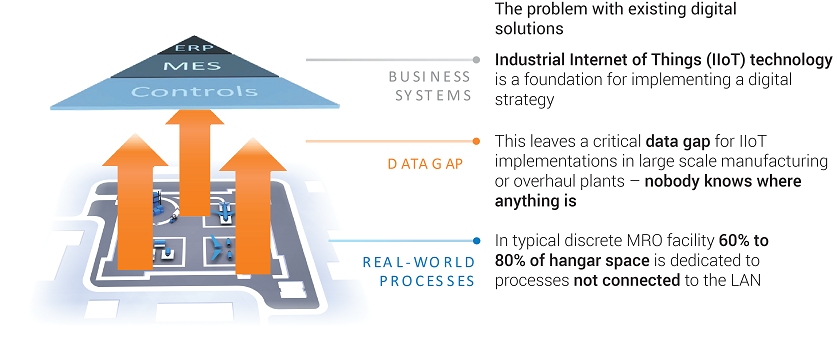
Ubisense SmartSpace closes that data gap by keeping track of the location, movement, interaction and status of all critical hangar assets. By keeping business systems constantly appraised of deviations from plan, those systems are better able to get things back on track. In any process with moving parts, the motion and interaction of those parts (tools, WIP, materials etc.) is the critical indicator of how things are going.
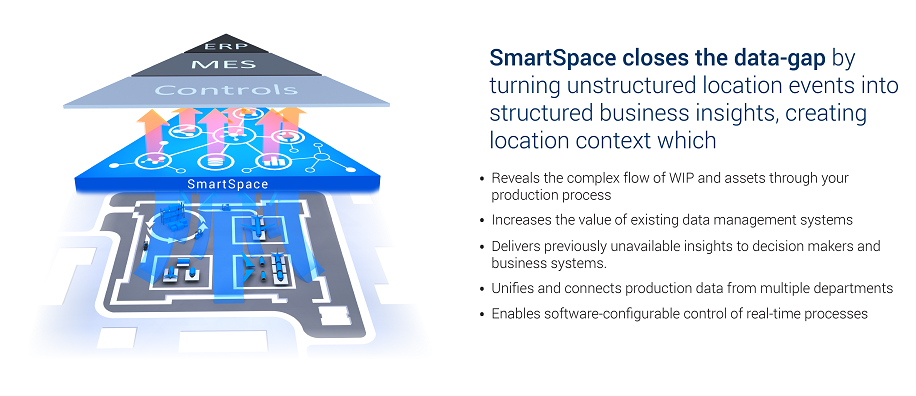
Once the location of all those parts are known it is possible to monitor the related processes and start to improve your overall business efficiency in your MRO environment.
Do you want to learn more on How to Improve Business Efficiency in an Aerospace MRO Environment? Watch Dr Hugh Revie’s On-Demand Webinar on the same topic: WATCH NOW
DEFINING THE DIGITAL TWIN
In this section we want to establish what is meant by the term ‘digital twin’ and how it applies to the MRO environment.
The term can lead to confusion since there are many examples of digital twins which mirror multiple kinds of real-world objects. Some of the more commonly used examples are:
- Product design: a digital representation of a product to be manufactured;
- Manufactured product: a digital history of the use and state of a product throughout its life;
- Facility design: a digital representation of a building or facility to be built;
- Industrial equipment: a digital status of all equipment running in a facility during operations;
This last category is the province of IoT: sensors monitoring information about equipment and devices feeding that data to the cloud to perform such services as preventive maintenance. But the state of equipment and devices is not at all the same thing as the status of complex manual processes. The vibration of the motor of an electric screwdriver does not tell us if we are on track to meet a turnaround time target.
It’s clear that an MRO hangar does not fit into any of these definitions and that a new kind of digital twin is required: a digital twin of the hangar, representing the status and interactions of all the parts of the process: WIP, tools, material and people. This digital twin needs to answer the question: how are we doing against plan? More importantly, this twin should answer a more fundamental question: is anything happening that might indicate we are about to deviate from plan?
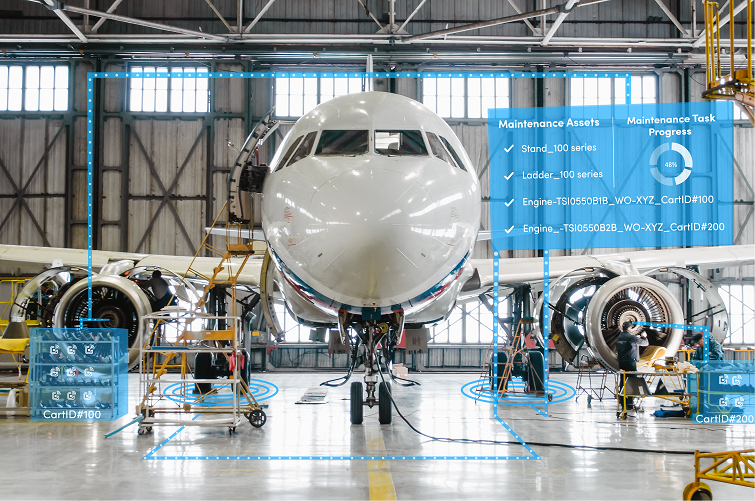
SmartSpace does exactly that, by integrating existing business data (like work orders, maintenance procedures, calibration and maintenance schedules) with information from sensors about the location of assets. It creates full visibility of the process as it unfolds, comparing activity against plan to highlight issues that threaten compliance and turnaround time.
In other sectors, the concept of the digital process twin is already being used extensively. In manufacturing, for example, this technique is used to allow planning and control systems to gain unprecedented visibility of, and control over, complex processes. From error-proofing manual assembly tasks, to optimizing flow through repair and rework activities, manufacturers have experienced leaps in quality and productivity.
There’s no magic to this. It’s been said that you can’t improve what you can’t measure, and you can’t measure what you can’t see, so visibility is always the first step in any process improvement. As we have stated, most manual, moving tasks are invisible to traditional IoT approaches, but the digital process twin fills that gap, shedding light on every activity as the process unfolds.
The information that can be passed up to planning and control functions from such a digital twin includes historical performance data, current progress against plan and real-time indications of critical errors and deviations.

In the next section we will describe the MRO Digital Twin in more detail and start to see how the efficiencies can be realised within an MRO environment.
The MRO Digital Twin
The Key Pillars of MRO
As discussed in the previous section, the Digital Process Twin is what we are creating in the MRO environment and to do this we need to understand how all the key pillars of MRO interact with one another to help define and monitor the process.
The pillars of MRO are:
- The tasks that should be managed within the MRO processes
- People and the various skills that are required to perform the tasks
- The tooling required for each task and
- The material required
Each of these pillars is discussed in further detail highlighting some key components and areas where value can be realized.
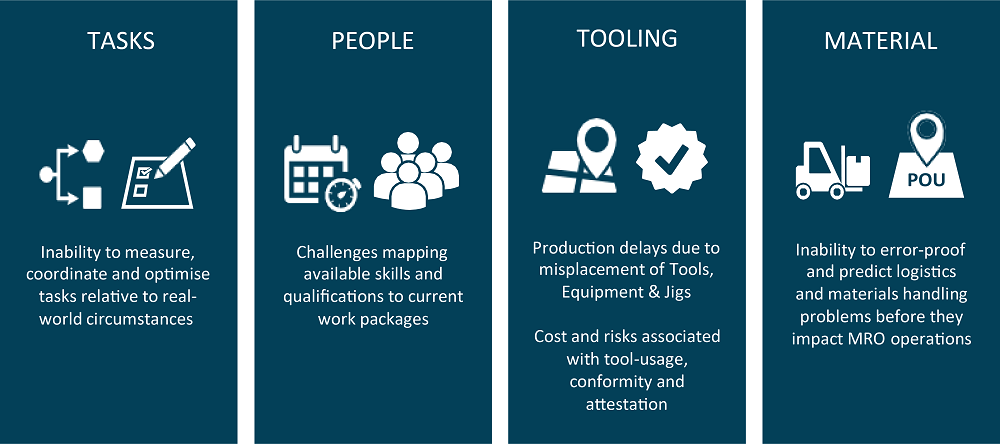
1. Tasks
Looking first at the tasks, here are some examples of how tasks can be scheduled and coordinated effectively within an environment, where the user creates the rules within SmartSpace to manage what gets done, when and how.
- Plan efficiently using actual data
- Record actual vs planned activities
- Record findings over time, resource, skills and materials for information that can be used in future planning
- Execute consistently
- Save the plan template for training, insight and future use
2. People
This is about making sure that the right people are available and, if the business allows it, to track those people to know where they are. In most cases, people get allocated to particular work orders or tasks so it’s possible to know where they should be. Here are a few examples of what can be captured and monitored to review what is working well and what is not working well within that facility and returning the value through the business.
- Check/monitor skills required to complete planned tasks
- Check/monitor currency of qualifications of those with correct skills
- Allocate specific technicians to tasks
- Manage and control enablement of Electronic Task Cards for technicians on mobile devices
- Record time spent on tasks
- Sign completion/closure of tasks
3. Tooling
This can be managed through a digital twin and is one area where many of those adopting this technology start, by managing how they issue the tools out and where the tools are to ensure that they are always controlled. Again, here is a sample list of what can be achieved to ensure that tooling is available, conformant and able to be located:
- Ensure tooling is serviceable
- Ensure tooling is available
- Deliver tooling to zone prior to need
- Confirm use of tooling
- Return tooling to storage
With ground support equipment (GSE) or larger more expensive tooling, SmartSpace can help to understand how these tools are managed including their utilization. Another example could help manage tooling: when a tool is issued to one individual, instead of going back to the tool store, it can be transferred to another individual but still be controlled through the inventory management process. This is possible because, with SmartSpace, the user knows where the different people are and knows where the tools are so that people can exchange tools easily and in a controlled manner within this environment. With real-time tracking of GSE, a team lead awaiting a specific GSE can be notified instantaneously when it becomes available and claim it faster, thus reducing the overall time-span of a repair.
4. Material
It is always important to know where material or components are. Is it at the right place at the right time so that the user can pre-draw the material and get it to the point of use in a timely manner? The solution can also manage the store so that the business knows how much material is available (how many consumables or other types) and can manage that in real time as well as pull all that information together. Again, here is a short list of aspects of material management that need to be considered:
- Check material is available, if not place an order
- Prepare material for delivery to zone just in time but prior to demand
- Confirm consumption of material and recover possible lag time in replenishment
- Arrange for return to store of unused stock
SINGLE PLATFORM
As always, the trick to digitizing a hangar is to find a single solution that solves multiple problems, rather than a unique solution to each problem. SmartSpace is architected as just such a platform that delivers visibility of all internal processes and activities, as shown in the figure below.
There are three main categories of value that a platform like this can deliver:
- Visibility
- Error-Proofing
- Audit
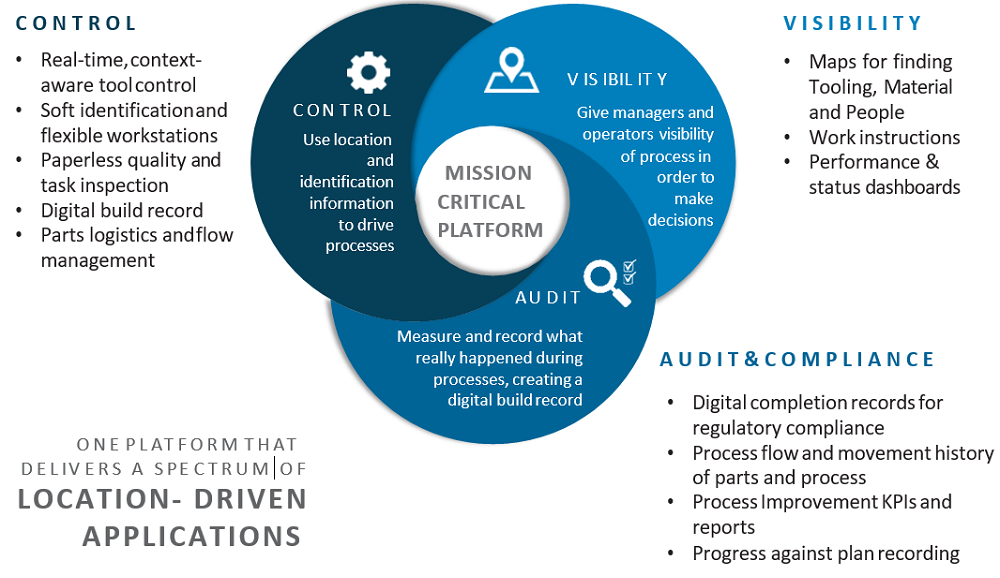
1. Visibility
Adding a location context to other business data enables a very intuitive view of both assets and processes. Clearly a map of tools, material and other assets is helpful when gathering the necessary equipment for a task, but a simple view of tasks allocated across that map can add a valuable context to workflow. In one example, a simple map of task status as allocated around an airframe provided insights that a simple table could not. Very simply, a “bird’s eye view” of the hangar is a very intuitive way to assimilate process status at a glance.
2. Error-Proofing
SmartSpace includes a rules engine that allows users to program expected process flow and leaves SmartSpace to detect errors and deviations. In this mode SmartSpace can be thought of as a wingman, constantly monitoring the hangar and drawing your attention to any issues that might affect compliance or turnaround time.
3. Audit
By monitoring the flow and interaction of critical assets against tasks, detailed automatic compliance records can be established. This not only supports process audit, but equipment utilization monitoring: the historical flow and use of equipment informs future equipment needs, as well as optimal storage and routing (5S).
Once we have built the MRO Digital Twin of your business it is now possible to start driving real value. In the final Blog of this series I will detail a number of use cases and areas where MRO businesses can start to drive real value.
Do you want to learn more on How to Improve Business Efficiency in an Aerospace MRO Environment? Watch Dr Hugh Revie’s On-Demand Webinar on the same topic: WATCH NOW
Airframe Heavy Maintenance – An Overview
Current situation
When a 3rd party MRO company wins a contract to complete heavy maintenance on an aircraft, the process to create the work pack starts some months prior to the aircraft arriving at the MRO hangar. The tasks to be completed are agreed along with the contract terms. This work can contain hundreds of tasks that need to be meticulously planned. This is generally completed by a planning department with personnel who understand the process and the aircraft to be worked on.
Normally, MRO companies will use specialised software to build and execute the plan. Some examples of this specialised software are AMOS, TRAX, Mxi, Rusada, Ramco etc. A final draft plan is completed prior to the aircraft arriving at the facility and initial meetings are held between the planning department and the execution team to ensure the planned check is workable.
Once agreed, operations take over the management of the work order. If the business operates using paper cards, they print the cards out and order them generally in a rack as shown in the image.
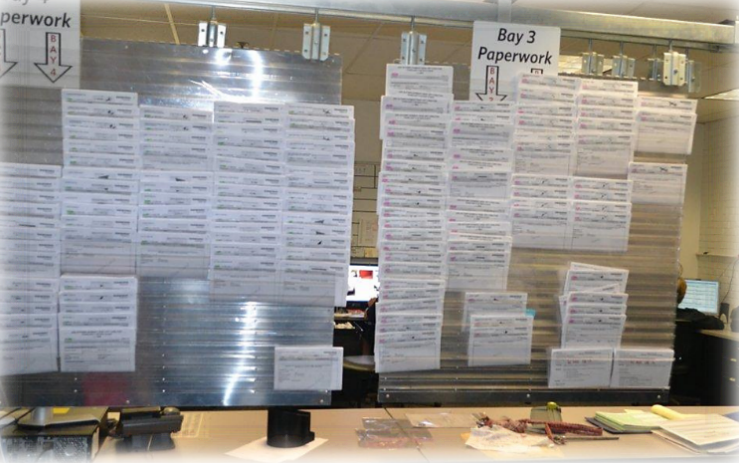
Areas that can be improved
Many MRO companies have introduced manual systems or processes to manage the complexities and interactions between the tasks, technicians, tooling and material. This generally involves daily or shift review meetings, detail project plans and other adhoc activities.
The review meetings become a crucial way for management to stay on top of each work order to ensure minimal slippage. This is mainly due to the unforeseen issues that can arise within each work order. I have been involved in meetings that involved between 5 and 10 people each time and the meeting time-span ranges between 15 min to more than an hour. Examples of these unforeseen issues include:
- unexpected non-routine issues discovered during early inspections e.g. corrosion
- material shortages
- skill shortages
If the work order had no unforeseen issues then the review meetings would not be unnecessary. Unfortunately, most work orders have these types of issues.
Most companies will create a project plan either as an embedded plan in the MRO software or as a separate plan in the project planning software. At one company I worked with, each check was managed by 2 project managers to ensure the overall work order was completed to plan. Every time there was a change to the plan, a new plan was redrafted for the supervisors and technicians to follow.
The whole overview and management process is very labour intensive but necessary because most companies do not have the visibility of what is actually happening in the work order.
How the issues were addressed by Ubisense
Ubisense has addressed these complex and valuable work orders (these can be more than £250k per work order) by focusing on the underlying business processes.
The first issue addressed was the lack of visibility of the progress to management and others, and issues being discovered during the work order.
The second issue was the impact that the unforeseen issues would have on the overall work order – i.e. will the work order still be able to be completed in the same timescale.
The third issue was the lack of a common communication system where any issues raised were clearly identified, described, actioned, where responsibility for the action was clearly identified, and where a resolution to the issue was also clearly articulated and added to the communication system.
Once each of these issues were addressed there was no further need to have the regular review meeting. The issues were addressed in real time with full visibility to all who needed to see the impact and/or the resolution.
SmartSpace enabling benefits
SmartSpace is a location based solution and as such each entity in the solution requires an x, y, z location. The first phase of any SmartSpace solution is the development of an accurate 3D model of the customer’s hangar. In the model, we develop rules that define what the assets we place in the model can or cannot do. SmartSpace also integrates with the customers existing solutions including MRO, ERP, HR etc. and uses the existing data through integration to help manage the work orders effectively.
In this particular use case, we have a model of a hangar and a model of the aircraft to be placed in the hanger to which the work order applies.
Each task that has been planned for this particular work order could be visualised in the Planning Office of the model while it is being developed since that is where the x, y, z coordinates of the tasks will be. Once the work order is released, the tasks move to the supervisor’s office and either immediately or when the supervisor displays them on his board will be visualised on the electronic task board. This can be seen by anyone with access to the SmartSpace solution.
As the supervisor issues the tasks or the technicians select them, the tasks move to the relevant zone on the aircraft or to a general area defined by the customer. Every task has a working location that is related to the aircraft or hangar. Since we know the aircraft’s location in the hangar, we can now display on the hangar model where these tasks are and who is working on them. This then lets management or anyone with the right level of access to SmartSpace have a bird’s eye view of the check as it is being completed.
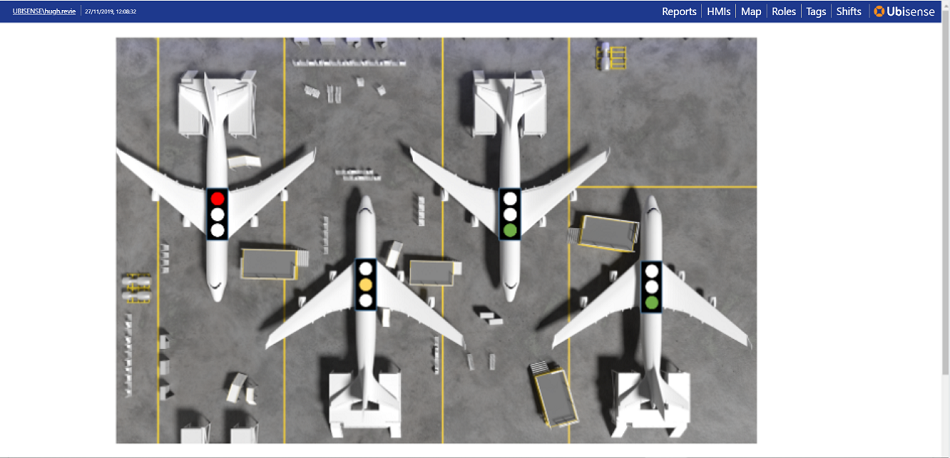
Through the SmartSpace business rules the activities can be colour coded to highlight any non-routines and also whether they were expected non-routines or unexpected non-routines. This provides the real time view and status of each work order as it is being completed.
The second issue that was addressed was to provide management and users visibility of the impact to the work order that unforeseen issues may have on the execution plan. Using the business rules within SmartSpace, and through these rules enabling customers to connect tasks with related tasks, ensures any impact affecting one part of a series of linked tasks will affect all linked tasks. This then continually reviews and re-plans the work order real time taking into account any unforeseen issues that have been discovered. In addition to the continual re-planning, an on time metric is included in the dash board to provide management with the Turn-Around-Time (TAT) metric and on-time performance. Therefore, management can now see real time what is happening during the work order and what impact any unforeseen issues may have on the overall work order.
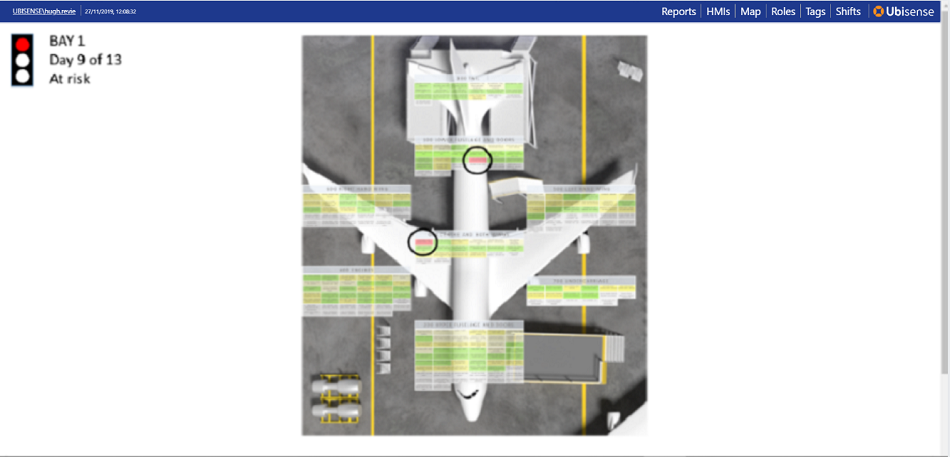
Finally, the third issue is addressed again using the business rules that define who should be responsible for actioning any unforeseen issues. The moment an unforeseen issue is discovered, the business rules kick in with a message to the responsible person. Metrics are in place within SmartSpace to provide an escalation in the event that the responsible person does not action within the specified time scale set up by the customer, and ensure appropriate timely action is recorded and visible to all who need to see it. This provides an auditable and traceable record of the process not only of finding the unforeseen issue but also the actioned record. This information would generally be transferred to the MRO solution as a permanent record.
SmartSpace therefore enables all those involved in the management process to see at every stage of a work order how it is performing and whether it will be completed on time.
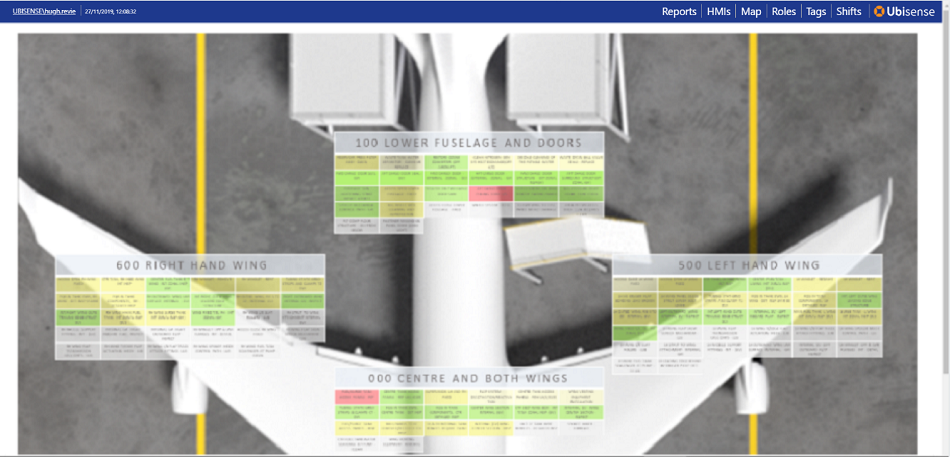
From the above, you can see how real-time asset tracking and digital twins are improving processes for MRO operations in a variety of ways. If you have any questions about what Ubisense could do for your MRO operation, please contact us to learn more.
